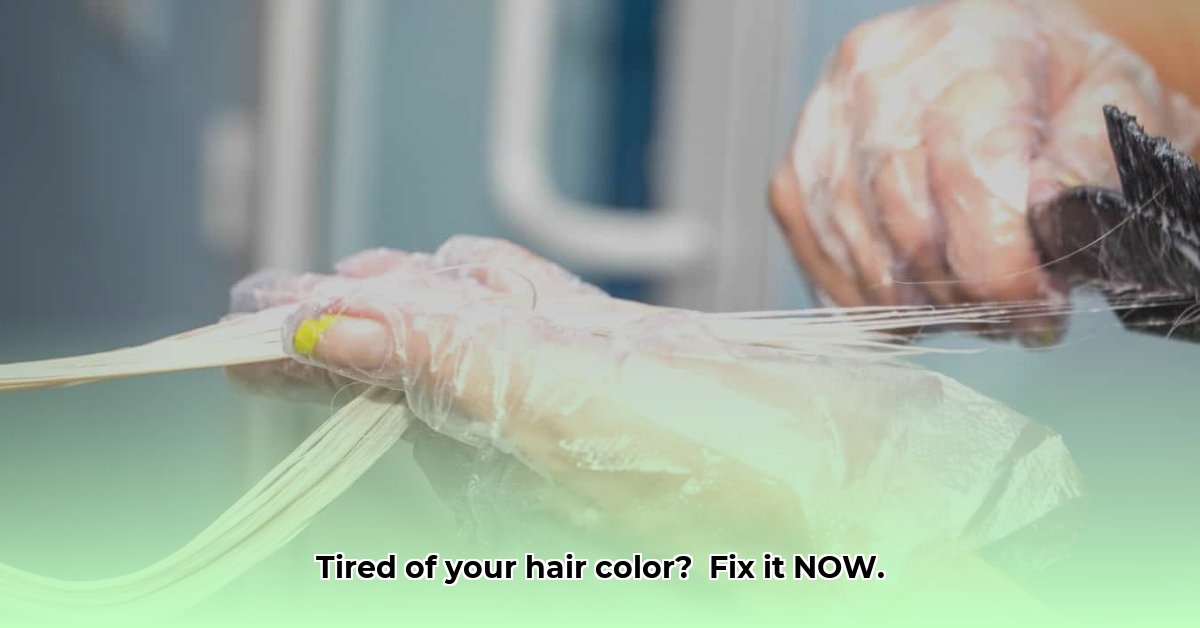So, your hair dye adventure took an unexpected turn? That “permanent” color might feel like a life sentence, but don’t worry, you’re not alone! Whether you’re battling a shade too dark, unexpected brassy tones, or a color that clashes with your vibe, this guide offers a rescue plan. We’ll explore everything from DIY remedies using kitchen staples to professional salon options for a color overhaul. Put down the scissors, take a deep breath, and let’s get your hair back on track.
Understanding the Science of Hair Dye Removal
Before we jump into solutions, understanding why permanent dye is so stubborn is helpful. “Permanent” hair dye contains molecules that penetrate deep into the hair shaft, reacting and expanding to lodge themselves within the hair’s structure. This is why it lasts longer than temporary dyes that merely coat the surface. Over time, washing, sunlight, and styling cause these molecules to break down and fade, but sometimes, a quicker fix is needed. This guide will help you navigate this complex process safely and effectively.
DIY Color Removal: Kitchen Chemistry for Your Hair
DIY methods can sometimes lighten or fade unwanted color, but complete removal might be challenging. These methods work by gently lifting color molecules from the hair’s surface or shrinking the dye molecules. Always do a strand test before applying anything to your whole head to assess your hair’s reaction.
Clarifying Shampoo & Baking Soda: A Gentle Nudge
- What it does: Baking soda acts as a mild abrasive, helping to lift color molecules from the hair’s surface.
- How to: Mix equal parts clarifying shampoo and baking soda into a paste. Apply to damp hair, leave for 15 minutes, and rinse. Repeat a few times if needed, but be mindful of dryness.
- Precautions: Baking soda can be drying, so use sparingly and follow with a moisturizing conditioner.
Vitamin C Treatment: The Antioxidant Approach
- What it does: Vitamin C is believed to oxidize the dye, breaking it down and making it easier to remove.
- How to: Crush vitamin C tablets and mix them with hot water to form a paste. Apply to hair, cover, and wait 30-60 minutes. Rinse thoroughly.
- Precautions: While generally gentle, some individuals may experience scalp irritation. A patch test is recommended.
Oil Treatment (Olive, Coconut, or Argan): Deep Conditioning and Subtle Fading
- What it does: Oil may help loosen dye molecules and condition the hair. Some oils, like coconut, might have slight lightening properties.
- How to: Warm the oil (do not overheat!), apply generously to hair, cover with a shower cap, and leave for at least 30 minutes. Rinse thoroughly.
- Precautions: This method is more about conditioning and subtle fading than dramatic color removal.
Lemon Juice & Conditioner: A Touch of Lightening (With Caution!)
- What it does: Lemon juice’s acidity can have a mild lightening effect, especially when combined with sun exposure.
- How to: Mix equal parts lemon juice and conditioner. Apply, leave on for an hour, and rinse. Sunlight can enhance the effect, but be mindful of sun damage.
- Precautions: This method may not be as effective on dark hair and can cause dryness.
Professional Color Removal: Expert Solutions for Stubborn Dye
If DIY methods aren’t delivering the desired results, or if you’re concerned about potential damage, professional color removal is the safest and most effective option. Stylists have access to specialized products and techniques designed to minimize damage and maximize color removal.
Color Correction: Fine-Tuning for Precision
Color correction targets specific unwanted tones using a customized blend of colors, refining rather than removing the existing color. This is suitable for addressing issues like brassiness or ashy tones. Expect to pay between $50 and $150, depending on the complexity.
Bleaching: A More Intensive Approach
Bleaching lifts artificial color molecules from the hair shaft and is necessary for significant color changes or removing darker dyes. It requires a skilled stylist to minimize damage. Costs typically range from $75 to $200 or more.
Sulfur-Based Color Removers: A Gentler Alternative
These products shrink dye molecules, making them easier to rinse out. They are a less aggressive alternative to bleach, but their effectiveness may vary. Costs generally range from $60 to $150.
Choosing a Professional: Expertise Matters
Seek a stylist specializing in color correction. Check reviews, ask for recommendations, and have a thorough consultation to discuss your hair history, desired outcome, and realistic expectations.
Damage Control and Aftercare: Reviving Your Hair
Any color removal process can stress your hair. Deep conditioning treatments, protein masks, and color-safe products are crucial for restoring moisture, strength, and shine.
Prevention: Avoiding Future Color Dilemmas
- Strand Test: Always do a strand test before applying any hair dye.
- Temporary or Semi-Permanent Options: Consider these for less commitment and easier removal.
- Professional Consultation: For major color changes, consult a stylist beforehand.
FAQ: Addressing Common Concerns
- Will these methods damage my hair? DIY methods carry a risk of dryness or damage if used improperly. Professional methods are generally safer when performed by a skilled stylist.
- Can I completely remove permanent color at home? It’s challenging. DIY methods mostly fade the color. Professional methods offer a better chance of complete removal.
- How long will removal take? It depends on the method, your hair, the dye used, and the desired result. Patience is key.
Comparing Hair Color Removal Methods
| Method | Effectiveness | Cost | Potential Hair Impact |
|---|---|---|---|
| Clarifying Shampoo/Baking Soda | Low-Moderate | Low | Dryness (if overused) |
| Vitamin C | Moderate | Low | Possible Irritation |
| Oil Treatment | Low | Low | Minimal |
| Lemon Juice/Conditioner | Low-Moderate | Low | Dryness, Sun Sensitivity |
| Color Removing Products | Moderate-High | Moderate | Moderate-High |
| Professional Color Correction | High | High | Low (with skilled stylist) |
| Professional Bleaching | High | High | Moderate-High (with skilled stylist) |
This guide provides general information. When in doubt, consult a qualified hairstylist for personalized advice. They can assess your hair’s condition and recommend the safest, most effective approach for your specific needs.
- How to Measure Your Belt Size (for Women): 3 Easy & Accurate Methods - April 27, 2025
- How to Remove Permanent Hair Dye From Hair: Safe & Effective Methods - April 27, 2025
- How to Remove Ink from Leather: Effective DIY Methods and Expert Tips - April 27, 2025










